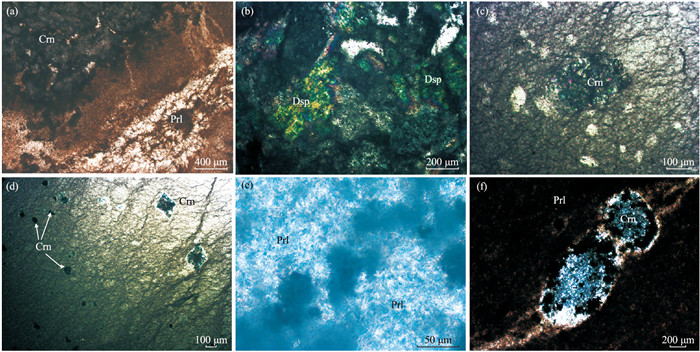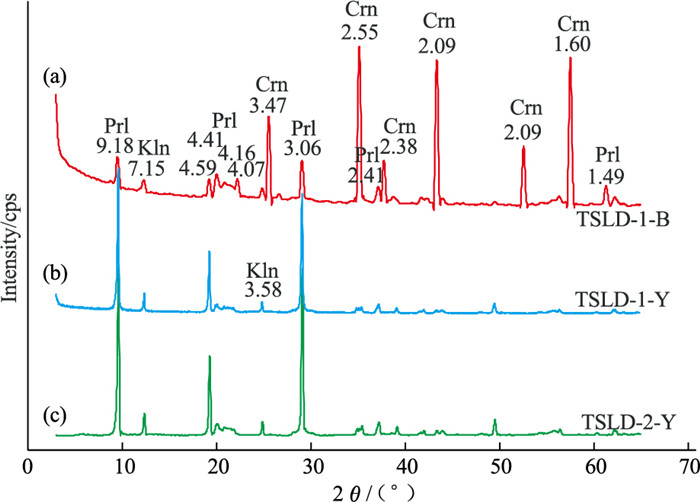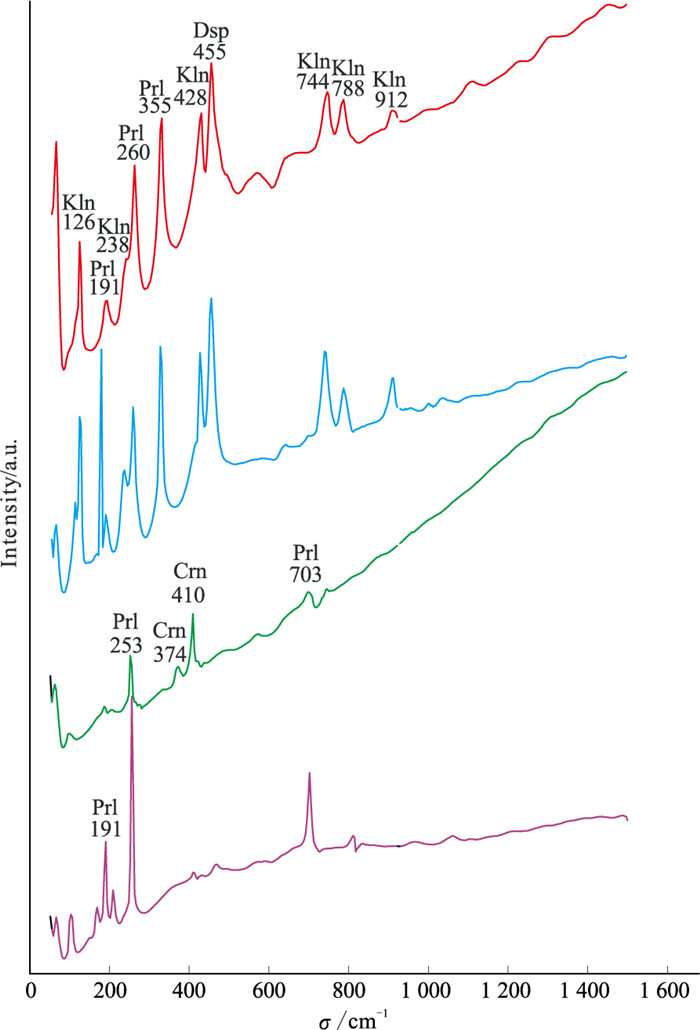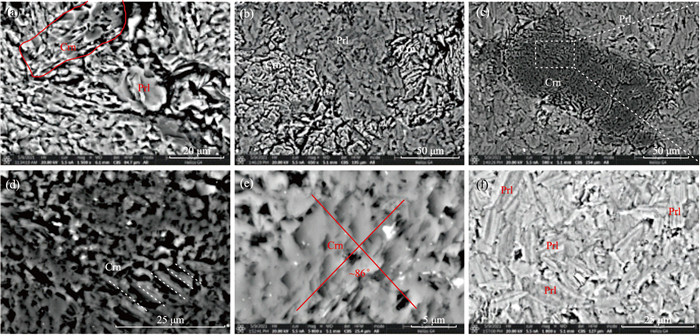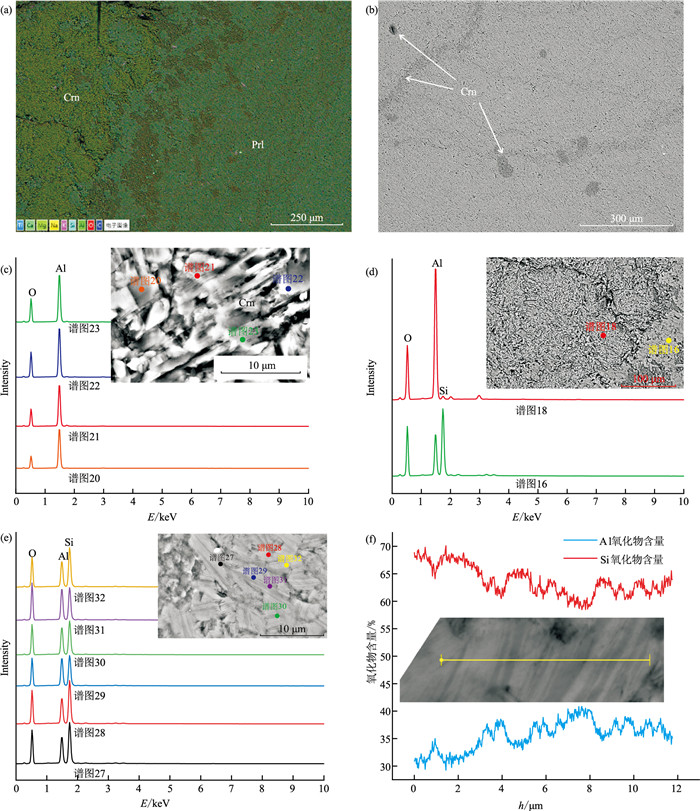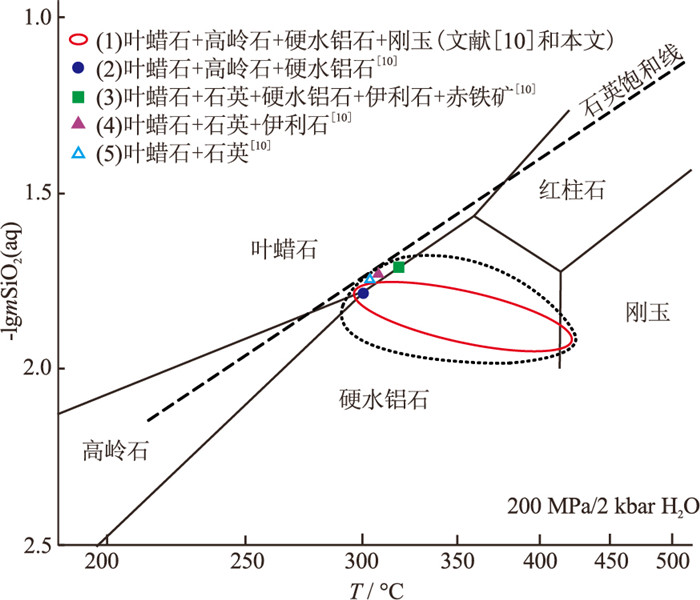Mineral Component and Its Genesis of Landai Taishun Stone from Zhejiang Province
-
摘要:
泰顺石被认为是“中国第五大图章石”,然而泰顺石的宝石矿物学特征及其形成成因很少受到关注。泰顺石蓝带作为一种带有鲜艳颜色的泰顺石,受到人们的喜爱,但目前其矿物组成和形成机制仍不清楚。本研究采用多种测试分析研究手段,对泰顺石蓝带样品进行了深入的宝石矿物学和微形貌分析,揭示了泰顺石中蓝带的形成条件和机制。利用薄片观察、X射线粉晶衍射和拉曼光谱分析,识别了泰顺石蓝带的主要矿物组成,发现其基质以叶蜡石为主并含有少量硬水铝石和高岭石,蓝带部分为刚玉;叶蜡石为2M多型和1Tc多型的混合,以2M型为主;蓝带部分刚玉的化学成分中含有Ti和Fe,是刚玉呈现蓝色的主要原因。其矿物组成上与青田石蓝花钉具有一致性。基于岩石矿物组合的相图和前人数据分析,泰顺石蓝带的矿物组成和叶蜡石的多型特征,10~430 ℃的变质温度环境有利于硬水铝石变质脱水,从而向刚玉发生转变。微形貌和能谱分析揭示,蓝带部分为新生刚玉,呈板状并含有孔隙,该特征是斜方晶系硬水铝石向三方晶系刚玉转变过程中,由于晶面的继承和对晶面不协调调整造成的,是硬水铝石向刚玉的脱水转化的直接证据。
Abstract:Taishun stone has been esteemed as "the fifth seal stone" in China, yet its mineralogical characteristics and genesis have been received relatively limited scholarly attention. The Landai Taishun stone, distinguished by its vibrant colouration, is highly prized and widely appreciated. However, the mineral components and formation mechanism of this variety remain to be comprehensively elucidated. This study employed a suite of analytical methods to investigate the gemmological and micromorphological characteristics of Landai Taishun stone samples, thereby revealing the conditions and mechanisms of the formation of the Landai within Taishun stone. Petrographic observation, X-ray powder diffraction, and Raman spectroscopy, identified the primary mineral components of Landai Taishun stone. The matrix predominantly consists of pyrophyllite with minor amounts of diaspore and kaolinite, while the Landai is composed of corundum. The pyrophyllite exhibits a mixture of 2M and 1Tc polymorphs, with the 2M type being predominant. The chemical composition of corundom in the Landai contains Ti and Fe, which are the main factors responsible for its blue colouration. The mineral component of Landai Taishun stone is consistent with that of Qingtian Landing stone. Based on the phase diagram of rock mineral assemblages and previous data analysis, the mineral component and the polymorphic properties of pyrophyllite suggest that the rock may have formed in a metamorphic environment at temperatures about 410-430 ℃, favorable for the dehydration and metamorphic transformation of diaspore into corundum. Detailed micromorphological and energy dispersive spectroscopic (EDS) analyses revealed that the Landai portion comprises newly-formed corundum, exhibiting a plate-like morphology with porous features. These features are resulted from the transformation process of orthorhombic diaspore to trigonal corundum, driven by crystal face inheritance and subsequent misalignment adjustments, providing direct evidence of the dehydration-driven transformation of diaspore to corundum.
-
Keywords:
- Taishun stone /
- Landai /
- pyrophyllite /
- corundom /
- dehydration of diaspore
-
泰顺石是一种近年来逐渐兴起的印章石和雕刻石, 被认为是“第五大图章石”。泰顺石因产自浙江省温州市泰顺县而得名,其开发源于当地蕴藏的大型叶蜡石矿[1]。早期,泰顺石作为一种叶蜡石非金属材料被开采并运用到玻纤、陶瓷、涂料、耐火材料等行业[2]。雕刻相关的专业人士注意到泰顺龟湖叶蜡石与浙江青田石有类似的艺术价值,优质的泰顺石色彩艳丽,裂隙较少,具有较好的强度以及适中的硬度,是优质雕刻品的原材料,如梅花枝、灯光冻等是图章石销售及收藏市场上的精品。随着巴林石、寿山石、青田石和昌化石资源的逐渐枯竭,“后起之秀”泰顺石因品质高、储量高成为“中国第五大图章石”的强有力竞争者。
前人[1-5]对泰顺石相关的文化产业、成矿成因以及宝石学特征等开展了一定研究,范围较广,但总体较少。例如,陈巍巍[3]对比了青田石和寿山石的文化产业发展,提出了政府在推动泰顺石文化中可发挥的职能作用及具体措施。翟世达等[4]对龟湖矿区叶蜡石的短波红外光谱分析,认为龟湖蚀变岩帽具有形成斑岩-浅成低温热液矿床的潜力。朱选明等[5]根据泰顺石的富铝、硅、铁、硫化学特征,把泰顺石分成了不同类型叶蜡石型,并认为宝石级的泰顺石多为富铝叶蜡石型。以上研究指出了泰顺石形成属热液矿床体系,矿物组成以叶蜡石为主。然而,泰顺石品种众多,对特殊品种泰顺石蓝带的研究未见报道。
作为叶蜡石为主的石料,泰顺石蓝带可与青田石的蓝花钉、蓝星品种对比。前人[6-7]研究资料表明,青田石中蓝花钉和蓝星的致色矿物分别为微晶刚玉和蓝线石。但对于与叶蜡石共生的矿物组合,泰顺石蓝带的形成成因和机制仍不清楚。青田石中含蓝刚玉的叶蜡石的宝石学特征和成因分析认为,叶蜡石型蓝刚玉是在酸性、中-高温环境下经硬水铝石变质作用形成,该推测仅结合前人实验岩石学的相变温度证据[8],缺乏直接岩相学和矿物学证据。
泰顺石在主要矿物组成上与青田石、部分寿山石相似,均是属于叶蜡石质,它们之间存在一定的共性,因此研究泰顺石的宝石矿物学特征对区分不同来源的叶蜡石质图章石具有重要的意义。同时,对泰顺石蓝带的研究,有利于进一步厘清刚玉在叶蜡石型矿床中的形成机制。本研究从岩相学、矿物学等方面对泰顺石蓝带开展深入地研究,进一步了解泰顺石蓝带的宝石学矿物学特征,以期对比泰顺石与其他叶蜡石型图章石,并深入地探讨对泰顺石蓝带的形成成因。
1. 样品及测试方法
1.1 样品情况
本研究样品来自于泰顺市场收集到的2件典型泰顺石蓝带样品(图 1)。样品均显示出明显蓝色条带,其中样品TSLD-1有明显的不规则蓝色条带,蓝色条带与基质部分具有明显的界线,与基质接触处有一层透明层;而样品TSLD-2的蓝色条带较少,与基质接触界线不明显。泰顺石蓝带样品基质部分主要为黄色,呈现微晶结构,微透明,蜡状光泽。常规宝石学测试结果(表 1)显示,样品折射率为1.57(点测),3次测量取平均值得到相对密度分别为2.737和2.733,长、短波紫外荧光灯下观察均呈惰性。
表 1 泰顺石蓝带样品的外观和宝石学特征Table 1. Appearances and gemmological characteristics of Landai Taishun stone samples样品编号 透明度 光泽 质地 折射率(点测) 相对密度 紫外荧光 典型外观特征 TSLD-1 微透明 蜡状光泽 细腻 1.57 2.737 惰性 基质整体呈淡黄绿色,有明显的蓝色条带,蓝色条带的边界十分清晰,蓝带内部有白色物质呈线状横穿 TSLD-2 微透明 蜡状光泽 细腻 1.57 2.733 惰性 整体呈浅黄灰色,有较少的蓝色条带,蓝色条带的边界不清晰,蓝带与基质边缘有一层暗黄色物质 1.2 测试方法
对两块泰顺石蓝带样品切出蓝色条带和基质部分,岩石探针片送至河北省诚谱检测技术(廊坊)有限公司进行岩石薄片磨制。挑选蓝带和基质部分样品研磨成小于200目的矿物粉末,用于X射线粉晶衍射测试。
薄片观察在中国地质大学(武汉)采用型号为Zeiss Axioscope A1的偏光显微镜完成。先对薄片中的矿物组分进行初步判断,并总结其整体的结构特征以及不同矿物之间的交代关系、蚀变程度等,对显微镜下难以鉴别的矿物进行标注,后期利用拉曼光谱进一步确认。
X射线粉晶衍射分析在中国地质大学(武汉)地质过程与矿产资源国家重点实验室完成。采用的仪器为荷兰飞利浦公司生产的X’Pert PRO Dy 2198,Cu Kα靶。参数设定:电流30 mA,电压40 kV,2θ范围3°~ 65°,扫描步长0.016 71°,扫描速度0.417 78 (°)/s。测试结果与矿物pdf(2004版)卡片对比,确定样品矿物相,并观察是否存在含量较少的次要矿物。
拉曼光谱分析利用Bruker-R200L型拉曼光谱仪在中国地质大学(武汉)地质过程与矿产资源国家重点实验室完成,主要测试矿物为偏光显微镜下不能确认成分的矿物。测试条件:激发光源波长532 nm,设置测试模式为共聚焦,激光束斑直径25 μm,输出功率20 mW,测试范围100~2 000 cm-1,扫描叠加3次,每次持续时间30 s。
扫描电子显微镜分析在中国地质大学(武汉)地质过程与矿产资源国家重点实验室完成,仪器型号为AZtecOne XT,加速电压为5~15 kV,观测倍率20~500 000,二次电子高真空分辨率3 nm(30 kV),低真空分辨率3.5 nm(30 kV),室温18 ℃。测试前对岩石薄片样品进行喷铂处理,喷铂厚度约8 nm,主要针对泰顺石蓝带样品的蓝色区域和界线附近矿物进行观察,结合EDS能谱分析样品中蓝带部分的微结构、形貌与成分。
2. 结果与分析
2.1 岩相学特征
岩相学观察结果(图 2)表明,泰顺石蓝带样品薄片中存在大量细小的叶蜡石基质,条带状部分主要为刚玉,而在基质和条带的接触边缘存在硬水铝石。在单偏光镜下,样品TSLD-1中叶蜡石呈两种粒度大小不同的纤维-鳞片状集合体:大部分为隐晶质鳞片变晶结构,粒度在10 μm以下;部分区域有粒度较大的具微晶变晶结构的叶蜡石集合体,单纤维长度小于50 μm(图 2a)。部分区域可见正高突起,具有明显的平行消光,正交偏光镜下可见最高干涉色达到三级蓝的硬水铝石(图 2b)。
在与蓝带接触界线处,可见大量微晶的暗色矿物集合体,具有正高突起(图 2a),后经拉曼光谱鉴定为刚玉。样品TSLD-1中刚玉以两种形式的存在:一种为成片分布的隐晶质粒状变晶结构集合体(图 2a);另一种为充填于空隙中的微晶质粒状变晶结构的集合体(图 2c和图 2d)。由于探针片相对于薄片较厚,刚玉在偏光显微镜下呈现二级蓝紫色干涉色(图 2c和图 2d)。刚玉充填的空隙呈浑圆状(图 2c)和菱形状(图 2d),具有交代充填前置矿物的交代残余结构特征。
样品TSLD-2中基质主要为叶蜡石,呈微晶质鳞片状变晶结构,鳞片长度约为20~40 μm(图 2e)。在不规则空隙中,可见二级蓝干涉色的刚玉集合体,该集合体与叶蜡石接触边缘有一圈暗色矿物存在(图 2f)。
2.2 X射线粉晶衍射分析
X射线粉晶衍射结果(图 3)表明,泰顺石蓝带样品的主要矿物组合为叶蜡石和刚玉,并含有少量的高岭石。样品蓝色区域以刚玉为主(图 3中红色谱线),黄色区域则以叶蜡石为主(图 3中蓝色和绿色谱线),这与偏光显微镜下观察结果一致。样品中叶蜡石具有明显的9.18,4.59 Å和3.06 Å 三处强衍射峰,这与标准叶蜡石的衍射特征峰稍有偏差,但基本符合叶蜡石衍射谱峰的特征。叶蜡石的衍射峰尖锐,分裂清晰,说明泰顺石蓝带样品中叶蜡石的晶体结构有序度较高。
泰顺石蓝带样品中刚玉具有明显的3.47、2.55、2.09 Å和1.59 Å典型衍射峰。高岭石由于含量较低,衍射峰不明显。
2.3 拉曼光谱分析
基于手标本和偏光显微镜观察结果,针对部分未知矿物进行拉曼光谱测试,并与RRUFF光谱数据库中部分矿物的标准谱图进行对比,在误差范围内根据其特征峰进一步判断矿物,测试结果如图 4。泰顺石蓝带样品的基质主要为叶蜡石,其拉曼光谱特征峰位于191,253~ 260,355 cm-1和703 cm-1处。除叶蜡石外,样品基质中还存在少量硬水铝石(455 cm-1)和高岭石(126、238、428、744、788 cm-1和912 cm-1),如图 4中红色谱线和蓝色谱线。
样品蓝色部位的拉曼光谱(图 4中绿色谱线和紫色谱线)显示明显410 cm-1和374 cm-1处的振动谱峰,对比RRUFF拉曼光谱数据库,为刚玉的拉曼光谱特征峰。
2.4 扫描电子显微镜分析
对泰顺石蓝带样品的蓝色和黄色接触界线处进行扫描电子显微镜微形貌和结构分析,结果如图 5。样品TSLD-1界线附近显示了刚玉和叶蜡石共存(图 5a—图 5c)。其中,叶蜡石呈鳞片状,大约20~30 μm,沿晶面(001)方向发育较差,呈薄片状。扫描电子显微镜二次电子图像显示,叶蜡石在沿晶面(001)方向有明显的明暗条带变化(图 5b—图 5c)。刚玉(暗色区域)主要填充在叶蜡石基质的空隙中(图 5c),呈板状发育,具有一定的定向性,集合体中具有较大的孔隙度(图 5d)。样品TSLD-2中部分刚玉晶体呈板状并伴随有溶蚀坑分布(图 5e)。在局部,叶蜡石晶体颗粒较大,具有明显的沿晶面(001)方向明暗条带变化(图 5f)。
利用扫描电子显微镜能谱对泰顺石蓝带样品进行分析。蓝带接触界线附近的多元素面扫结果(图 6a)显示,蓝带中蓝色部分比其他部分具有更高含量Al。单点能谱分析显示,条带状和空隙中填充的刚玉的Al和O摩尔比为2∶3,符合刚玉的元素特征(图 6b—图 6d,表 2)。除Al和O外,刚玉的能谱分析还检测出Ti和Fe,10个点的平均含量分别为0.13 wt%和0.31 wt%。Fe和Ti元素使得刚玉呈现蓝色,从而聚集形成蓝带。
![]() 图 6 泰顺石蓝带样品中典型矿物的能谱分析:(a)蓝带接触界线附近的多元素面扫描;(b) 条带和孔隙中刚玉分布的二次电子形貌像;(c-d)接触带处叶蜡石和刚玉的能谱分析;(e) 明暗条带变化的叶蜡石单点能谱分析;(f) 明暗条带变化的叶蜡石沿(001)方向Al和Si的含量变化Crn-刚玉,Prl-叶蜡石Figure 6. Energy dispersive spectra analyses of typical minerals in Landai Taishun stone samples: (a) multi-element energy dispersive spectrum scanning image near contact zone of Landai; (b) secondary electron morphologies showing the corundum distribution in bands and pores; (c-d)energy dispersive spectra analyses of pyrophyllite and corundum in the contact zone; (e) single point energy dispersive spectra analysis of pyrophyllite with varying light and dark bands; (f) the contents of Al and Si in pyrophyllite with varying light and dark bands along the direction (001)表 2 泰顺石蓝带样品刚玉能谱点位的元素含量Table 2. Elemental contents of corundum of Landai Taishun stone samples under spot analyses of EDS
图 6 泰顺石蓝带样品中典型矿物的能谱分析:(a)蓝带接触界线附近的多元素面扫描;(b) 条带和孔隙中刚玉分布的二次电子形貌像;(c-d)接触带处叶蜡石和刚玉的能谱分析;(e) 明暗条带变化的叶蜡石单点能谱分析;(f) 明暗条带变化的叶蜡石沿(001)方向Al和Si的含量变化Crn-刚玉,Prl-叶蜡石Figure 6. Energy dispersive spectra analyses of typical minerals in Landai Taishun stone samples: (a) multi-element energy dispersive spectrum scanning image near contact zone of Landai; (b) secondary electron morphologies showing the corundum distribution in bands and pores; (c-d)energy dispersive spectra analyses of pyrophyllite and corundum in the contact zone; (e) single point energy dispersive spectra analysis of pyrophyllite with varying light and dark bands; (f) the contents of Al and Si in pyrophyllite with varying light and dark bands along the direction (001)表 2 泰顺石蓝带样品刚玉能谱点位的元素含量Table 2. Elemental contents of corundum of Landai Taishun stone samples under spot analyses of EDS点位号 O/% Na/% Mg/% Al/% Si/% K/% Ca/% Ti/% Fe/% Br/% 阴阳离子摩尔数比 点1 47.2 bdl 0.02 50.2 2.02 0.02 0.02 0.21 0.30 bdl 3.00∶1.98 点2 47.0 0.02 bdl 52.2 0.27 bdl bdl 0.01 0.54 bdl 3.00∶2.00 点3 46.9 bdl bdl 52.0 0.36 0.02 bdl 0.06 0.62 bdl 3.00∶2.00 点4 43.1 bdl bdl 47.7 0.43 0.07 bdl 0.10 0.31 8.26 3.00∶1.99 点5 47.2 0.05 0.01 50.4 1.95 0.02 0 0.13 0.25 bdl 3.00∶1.99 点6 43.5 bdl bdl 47.4 0.91 bdl 0.03 0.30 0.17 7.67 3.00∶1.99 点7 43.1 0.04 0.01 46.7 1.21 0.04 0.03 0.21 0.18 8.46 3.00∶1.98 点8 43.0 bdl 0.10 46.2 1.49 bdl 0.03 0.15 0.17 8.91 3.00∶1.98 点9 47.0 0.01 0.01 52.3 0.37 bdl bdl 0.08 0.26 bdl 3.00∶2.00 点10 47.0 0.01 bdl 52.0 0.53 bdl 0.08 0.04 0.32 bdl 3.00∶2.00 平均值 45.5 0.01 0.02 49.7 0.95 0.02 0.02 0.13 0.31 8.33 3.00∶1.99 注:bdl表示低于检测限;能谱点位为重新整理的刚玉点位 对于沿(001)方向具有明暗条带变化的单点能谱分析结果(图 6e)表明,矿物均含有Si,Al和O元素,元素摩尔比值与叶蜡石中各元素比值较为一致。明暗条带变化的叶蜡石的能谱线扫描分析结果(图 6f)显示,暗色条带部分相比浅色部分更加富Al和贫Si。
3. 泰顺石蓝带矿物组成、形成条件和成因机制
3.1 泰顺石蓝带矿物组成及其与其他图章石对比
通过岩相学、X射线粉晶衍射分析和拉曼光谱测试对泰顺石蓝带样品的矿物组成进行分析,结果一致表明,泰顺石蓝带主要由叶蜡石和刚玉组成,并含有少量的硬水铝石和高岭石。
叶蜡石作为泰顺石蓝带的主要矿物组成,其晶体结构特征对品种的鉴别具有指示意义。叶蜡石一般可根据特定谱峰的差异分为2M型和1Tc型两种多型[9],在2θ=19°~22°范围内,1Tc型叶蜡石具有尖锐的4.43 Å(110)、4.27 Å(111)、4.07 Å(021)三个衍射峰,而2M型叶蜡石只有4.44 Å (110)、4.17 Å(111)两个弱且钝的衍射峰;在2θ=28°~31°范围内,1Tc型叶蜡石具有3.18 Å(022)、3.07 Å(003)、2.95 Å(112)三个呈山字型的衍射峰,而2M型叶蜡石只具有3.07 Å(003)一个强衍射峰。本文泰顺石蓝带样品在2θ=28°~31°范围内具有明显的2M型叶蜡石的特征,但在2θ=19°~22°范围内,仍具有1Tc型叶蜡石4.07 Å的弱衍射峰(图 3)。
对比不同地区叶蜡石型图章石,泰顺石蓝带与青田石中蓝花钉具有一致的矿物组成(表 3),但泰顺石中蓝色刚玉呈带状分布,而青田石蓝花钉中刚玉呈点状分布。
表 3 叶蜡石型图章石的矿物组成对比Table 3. Comparison of mineral components among pyrophyllite-type seal stones图章石名称 品种 主要矿物及多型 次要矿物 致色特征矿物 文献来源 泰顺石 蓝带 叶蜡石2M+1Tc 硬水铝石、高岭石 微晶刚玉 本文 泰顺石 叶蜡石2M 石英、硬水铝石、伊利石、高岭石 [10] 青田石 封门青 绢云母-叶蜡石2M 石英、高岭石 [6][11] 青田石 灯光冻 叶蜡石 石英 [6][12] 青田石 黄金耀 叶蜡石 石英 [6] 青田石 蓝花钉 叶蜡石 硬水铝石、高岭石 微晶刚玉 [6][7] 青田石 蓝星 叶蜡石-绢云母 红柱石、高岭石 蓝线石 [6][7] 寿山石 老岭石 叶蜡石1Tc和2M 硬水铝石、石英 [13] 寿山石 芙蓉石 叶蜡石2M 硬水铝石、石英 [14] 寿山石 芙蓉石 叶蜡石1Tc+2M 硬水铝石、石英、高岭石 赤铁矿 [15] 本文泰顺石蓝带样品中的次要矿物不含石英, 区别于其他叶蜡石型图章石。一方面可能与样品选取有关,由于样品选取较少而没有选取到含有石英的样品;另一方面,可能与泰顺石蓝带为充填型矿脉,而非交代型矿脉相关。此外,泰顺石蓝带的叶蜡石为2M型及少量1Tc型,与青田石封门青以2M型叶蜡石和寿山老岭石以1Tc型叶蜡石为主相比,具有差异[6, 11, 13](表 3)。但泰顺石蓝带中叶蜡石与寿山石芙蓉石中叶蜡石多型的差异仍无法确定,因为芙蓉石中叶蜡石多型的认定仍存在不同的观点[14-15]。
3.2 泰顺石蓝带矿物学特征对刚玉形成温度的指示
矿物的分解和生成是岩石在一定温压条件下达到相平衡的结果,矿物组合可作为反演矿物形成时温压条件的指示剂[16]。前人[10]利用泰顺石的矿物组合特征,对其形成温度进行了详细的研究,发现其矿物组合元素属于Al2O3-SiO2-H2O体系,根据矿物反应相图认为,含刚玉泰顺石的形成温度为410 ℃。综合研究显示,泰顺石蓝带的矿物组合由叶蜡石和刚玉组成,并含有少量的硬水铝石和高岭石。根据图 7显示,Al2O3-SiO2-H2O体系中含有刚玉可能对应形成温度至少有410 ℃,指示泰顺石蓝带的形成温度可能达到了410 ℃。
叶蜡石的多型转变与形成温度具有一定的联系[9]。叶蜡石单斜晶系(2M)变种形成于355 ℃以下,而三斜晶系(1Tc)多型则形成于375~430 ℃[17]。本文泰顺石蓝带基质以2M型叶蜡石为主,并含有少量1Tc型的晶体特征,可能指示泰顺石蓝带经历了至少375 ℃以上的变质温度。从叶蜡石多型转变推测所得到的温度与从其矿物组合推测得到的温度具有较好的一致性,指示了泰顺石蓝带的形成温度大约在410~430 ℃。
刚玉一般形成于高温富Al、贫Si的环境的内生或变质环境中。在变质过程中,刚玉可由硬水铝石脱水转变形成。高温脱水实验证实,在400 ℃以上,硬水铝石会向刚玉发生相变[19]。实验矿物学所获得硬水铝石向刚玉发生转变的温度与本文通过矿物组合和叶蜡石多型指示的温度具有很好的一致性,这可能也暗示泰顺石蓝带中刚玉的形成与硬水铝石的变质脱水有关。
3.3 泰顺石蓝带中刚玉的显微结构特征及其对形成机制的指示
由于硬水铝石为斜方晶系,而刚玉为三方晶系,硬水铝石向刚玉的转化往往伴随着晶体结构和形貌的变化。扫描电子显微镜观察发现,刚玉晶体呈多层片状,并伴随着一些孔隙(图 5a—图 5e),并被能谱证实为刚玉。刚玉为三方晶系,无解理,而层状和含孔隙结构的刚玉可能是硬水铝石转变过程中的过渡态形貌残留,主要原因是硬水铝石存在解理且扫描电子显微镜下更容易观察到板片状。
对于硬水铝石向刚玉发生转化,前人提出了很多模型,但均认为其在转化过程中会先形成过渡态/中间体[20-21]。Loffler L等[21]通过一系列高温X射线衍射和透射电子显微镜分析认为,在硬水铝石部分脱水过程中,刚玉的形成包含薄的高密度区和隔开高密度区的纳米级孔隙板片,持续脱水后或形成一个具有较大(001)晶面的硬水铝石同型过渡相,而纳米级孔隙板产生则由硬水铝石同型过渡相(001)晶面与刚玉(0003)晶面的不适应造成。因此,刚玉形成后往往含有很多的孔隙。这从理论上解释了本文泰顺石蓝带样品中的刚玉呈板状,并含有较多的孔隙。扫描电子显微镜微形貌观察结果也揭示了部分刚玉的形成可能与硬水铝石脱水转化为刚玉有关。
4. 结论
本文采用多测试分析手段,对泰顺石蓝带样品进行了宝石矿物学和微形貌特征分析,揭示了蓝带的形成条件和机制,具体结论如下。
(1) 薄片观察、X射线粉晶衍射和拉曼光谱分析结果显示,泰顺石蓝带的主要矿物组成为叶蜡石,并含有少量硬水铝石和高岭石,蓝带部分为刚玉。叶蜡石为2M多型和1Tc多型的混合,以2M型为主。蓝带部分刚玉的化学成分中含有Ti和Fe,是其呈现蓝色的主要原因。泰顺石蓝带在矿物组成上与青田石蓝花钉具有一致性。
(2) 基于岩石矿物组合的相图和前人数据结果分析,泰顺石蓝带的矿物组成和叶蜡石的多型特征,一致性地指示了该岩石可能形成于410 ℃以上的变质温度环境。这种环境有利于硬水铝石的变质脱水从而向刚玉发生转变。
(3) 微形貌特征和能谱分析揭示出泰顺石蓝带部分为新生刚玉,具有含有孔隙的板状形貌特征。该特征是由斜方晶系硬水铝石向三方晶系刚玉转变过程中晶面的继承和对晶面不协调的调整造成,是硬水铝石脱水转化为刚玉的直接证据。
-
图 6 泰顺石蓝带样品中典型矿物的能谱分析:(a)蓝带接触界线附近的多元素面扫描;(b) 条带和孔隙中刚玉分布的二次电子形貌像;(c-d)接触带处叶蜡石和刚玉的能谱分析;(e) 明暗条带变化的叶蜡石单点能谱分析;(f) 明暗条带变化的叶蜡石沿(001)方向Al和Si的含量变化
Crn-刚玉,Prl-叶蜡石
Figure 6. Energy dispersive spectra analyses of typical minerals in Landai Taishun stone samples: (a) multi-element energy dispersive spectrum scanning image near contact zone of Landai; (b) secondary electron morphologies showing the corundum distribution in bands and pores; (c-d)energy dispersive spectra analyses of pyrophyllite and corundum in the contact zone; (e) single point energy dispersive spectra analysis of pyrophyllite with varying light and dark bands; (f) the contents of Al and Si in pyrophyllite with varying light and dark bands along the direction (001)
表 1 泰顺石蓝带样品的外观和宝石学特征
Table 1 Appearances and gemmological characteristics of Landai Taishun stone samples
样品编号 透明度 光泽 质地 折射率(点测) 相对密度 紫外荧光 典型外观特征 TSLD-1 微透明 蜡状光泽 细腻 1.57 2.737 惰性 基质整体呈淡黄绿色,有明显的蓝色条带,蓝色条带的边界十分清晰,蓝带内部有白色物质呈线状横穿 TSLD-2 微透明 蜡状光泽 细腻 1.57 2.733 惰性 整体呈浅黄灰色,有较少的蓝色条带,蓝色条带的边界不清晰,蓝带与基质边缘有一层暗黄色物质 表 2 泰顺石蓝带样品刚玉能谱点位的元素含量
Table 2 Elemental contents of corundum of Landai Taishun stone samples under spot analyses of EDS
点位号 O/% Na/% Mg/% Al/% Si/% K/% Ca/% Ti/% Fe/% Br/% 阴阳离子摩尔数比 点1 47.2 bdl 0.02 50.2 2.02 0.02 0.02 0.21 0.30 bdl 3.00∶1.98 点2 47.0 0.02 bdl 52.2 0.27 bdl bdl 0.01 0.54 bdl 3.00∶2.00 点3 46.9 bdl bdl 52.0 0.36 0.02 bdl 0.06 0.62 bdl 3.00∶2.00 点4 43.1 bdl bdl 47.7 0.43 0.07 bdl 0.10 0.31 8.26 3.00∶1.99 点5 47.2 0.05 0.01 50.4 1.95 0.02 0 0.13 0.25 bdl 3.00∶1.99 点6 43.5 bdl bdl 47.4 0.91 bdl 0.03 0.30 0.17 7.67 3.00∶1.99 点7 43.1 0.04 0.01 46.7 1.21 0.04 0.03 0.21 0.18 8.46 3.00∶1.98 点8 43.0 bdl 0.10 46.2 1.49 bdl 0.03 0.15 0.17 8.91 3.00∶1.98 点9 47.0 0.01 0.01 52.3 0.37 bdl bdl 0.08 0.26 bdl 3.00∶2.00 点10 47.0 0.01 bdl 52.0 0.53 bdl 0.08 0.04 0.32 bdl 3.00∶2.00 平均值 45.5 0.01 0.02 49.7 0.95 0.02 0.02 0.13 0.31 8.33 3.00∶1.99 注:bdl表示低于检测限;能谱点位为重新整理的刚玉点位 表 3 叶蜡石型图章石的矿物组成对比
Table 3 Comparison of mineral components among pyrophyllite-type seal stones
图章石名称 品种 主要矿物及多型 次要矿物 致色特征矿物 文献来源 泰顺石 蓝带 叶蜡石2M+1Tc 硬水铝石、高岭石 微晶刚玉 本文 泰顺石 叶蜡石2M 石英、硬水铝石、伊利石、高岭石 [10] 青田石 封门青 绢云母-叶蜡石2M 石英、高岭石 [6][11] 青田石 灯光冻 叶蜡石 石英 [6][12] 青田石 黄金耀 叶蜡石 石英 [6] 青田石 蓝花钉 叶蜡石 硬水铝石、高岭石 微晶刚玉 [6][7] 青田石 蓝星 叶蜡石-绢云母 红柱石、高岭石 蓝线石 [6][7] 寿山石 老岭石 叶蜡石1Tc和2M 硬水铝石、石英 [13] 寿山石 芙蓉石 叶蜡石2M 硬水铝石、石英 [14] 寿山石 芙蓉石 叶蜡石1Tc+2M 硬水铝石、石英、高岭石 赤铁矿 [15] -
[1] 高原, 于春, 戴刚刚, 等. 浙江泰顺县白岩叶蜡石成因及成矿模式[J]. 重庆科技学院学报(自然科学版), 2016, 18(1): 4-7, 45. doi: 10.3969/j.issn.1673-1980.2016.01.003 Gao Y, Yu C, Dai G G, et al. The genesis and ore-forming model of the Baiyan pyrophyllite deposit in Taishun County, Zhejiang[J]. Journal of Chongqing University of Science and Technology(Natural Science Edition), 2016, 18(1): 4-7, 45. (in Chinese) doi: 10.3969/j.issn.1673-1980.2016.01.003
[2] 潘建强, 虞振声. 浙江泰顺龟湖叶蜡石矿物学特征及其应用研究[J]. 建材地质, 1991(1): 6-11. Pan J Q, Yu Z S. Mineralogical characteristics and application study of the Guihu pyrophyllite deposit in Taishun County, Zhejiang[J]. China Non-metallic Minerals Industry, 1991(1): 6-11. (in Chinese)
[3] 陈巍巍. 泰顺石文化产业发展中的政府职能研究[D]. 南昌: 江西农业大学, 2021: 1-36 Chen W W. Research on the government function in the development of Taishun stone cultural industry[D]. Nanchang: Jiangxi Agricultural University, 2021: 1-36. (in Chinese)
[4] 翟世达, 段士刚, 孙鹏, 等. 浙江泰顺龟湖叶蜡石矿床热液蚀变短驳红外光谱分析[J]. 矿床地质, 2022, 41(1): 189-201. Zhai S D, Duan S G, Sun P, et al. Short-wavelength infrared spectral analysis of hydrothermal alteration associated with Guihu pyrophyllite deposit in Taishun, Zhejiang Province, China[J]. Mineral Deposits, 2022, 41(1): 189-201. (in Chinese)
[5] 朱选民, 严俊, 夏立伟, 等. 浙江泰顺石暨叶蜡石型印章石的宝石学特征及分类探讨[J]. 宝石和宝石学杂志(中英文), 2014, 16(4): 39-48. doi: 10.3969/j.issn.1008-214X.2014.04.005 Zhu X M, Yan J, Xia L W, et al. Gemmological characteristics and classification of "Taishunshi" as pyrophyllite-type seal stone from Zhejiang Province[J]. Journal of Gems & Gemmology, 2014, 16(4): 39-48. (in Chinese) doi: 10.3969/j.issn.1008-214X.2014.04.005
[6] 商亮节. 青田石中若干冻石的矿物学特征研究[D]. 杭州: 浙江大学, 2013. Shang L J. Mineralogical characteristics of major Qingtian jelly jade[D]. Hangzhou: Zhejiang University, 2013. (in Chinese)
[7] 陈涛. 浙江青田石几个新品种的矿物学特征初步研究[J]. 岩石矿物学杂志, 2004, 23(2): 186-192. doi: 10.3969/j.issn.1000-6524.2004.02.012 Chen T. A preliminary study of mineralogical and spectroscopic characteristics of Qingtian stone[J]. Acta Petrologica et Mineralogica, 2004, 23(2): 186-192. (in Chinese) doi: 10.3969/j.issn.1000-6524.2004.02.012
[8] 朱选民, 亓利剑, 蒋红旗, 等浙江青田叶蜡石型蓝刚玉宝石学特征及成因初探[J]. 宝石和宝石学杂志(中英文), 2001, 3(4): 15-20. doi: 10.3969/j.issn.1008-214X.2001.04.005 Zhu X M, Qi L J, Jiang H Q, et al. Preliminary study on the gemmological characteristics and genesis of pyrophyllite-type blue corundum from Qingtian, Zhejiang[J]. Journal of Gems & Gemmology, 2001, 3(4): 15-20. (in Chinese) doi: 10.3969/j.issn.1008-214X.2001.04.005
[9] 杨献忠, 黄光昭, 李佩玉, 等. 寿山叶蜡石矿床中叶蜡石的多型及其转变[J]. 福建地质, 1993(12): 172-181. Yang X Z, Huang G Z, Li P Y, et al. Polymorphism and transformation of pyrophyllite in the Shoushan pyrophyllite deposit[J]. Geology of Fujian, 1993(12): 172-181. (in Chinese)
[10] 徐艳晓, 王朝文, 刘明军, 等. "泰顺石"的矿物学特征及其对成因的指示[J]. 矿物学报, 2021, 41(2): 213-223. Xu Y X, Wang C W, Liu M J, et al. Mineralogical characteristic of the "Taishunshi" and their genetic significances[J]. Acta Mineralogica Sinica, 2021, 41(2): 213-223. (in Chinese)
[11] 陈涛. 浙江青田石的宝石学研究[J]. 宝石和宝石学杂志(中英文), 2001, 3(3): 25-30. doi: 10.3969/j.issn.1008-214X.2001.03.006 Chen T. Gemmological study of Qingtian stone, Zhejiang[J]. Journal of Gems & Gemmology, 2001, 3(3): 25-30. (in Chinese) doi: 10.3969/j.issn.1008-214X.2001.03.006
[12] 朱选民. 青田石"灯光冻"品种的宝石矿物学特征及其成因[J]. 宝石和宝石学杂志(中英文), 2011, 13(1): 6-10. doi: 10.3969/j.issn.1008-214X.2011.01.002 Zhu X M. Gemmological and mineralogical characteristics and genesis of "Dengguangdong" in Qingtian stone[J]. Journal of Gems & Gemmology, 2011, 13(1): 6-10. (in Chinese) doi: 10.3969/j.issn.1008-214X.2011.01.002
[13] 周武邦. 寿山大山石和老岭石的宝石矿物学和地球化学特征及其对矿床成因的指示[D]. 武汉: 中国地质大学, 2022. Zhou W B. Gemological, mineralogical and geochemical characteristics and their implication for ore genesis of Dashan and Laoling stones in Shoushan [D]. Wuhan: China University of Geosciences, 2022. (in Chinese)
[14] 孙旎, 崔文元, 徐湘. 福建加良山寿山石的矿物学特征及其成因[J]. 岩石矿物学杂志, 2003, 22(3): 273-278. doi: 10.3969/j.issn.1000-6524.2003.03.013 Sun N, Cui W Y, Xu X. Mineralogical characteristics and genesis of Shoushan Stone in Jialiangshan, Fujian Province[J]. Acta Petrologica et Mineralogica, 2003, 22(3): 273-278. (in Chinese) doi: 10.3969/j.issn.1000-6524.2003.03.013
[15] 晏玉. 寿山"芙蓉石"的宝石学和矿物学特征研究[D]. 武汉: 中国地质大学, 2016. Yan Y. Gemological and mineralogical characteristics of Shoushan "Furong stone"[D]. Wuhan: China University of Geosciences, 2016. (in Chinese)
[16] Hemley J J. Some mineralogical equilibria in the system K2O-Al2O3-SiO2-H2O[J]. American Journal of Science, 1959, 257(4): 241-270. doi: 10.2475/ajs.257.4.241
[17] Eberl D. Synthesis of pyrophyllite polytypes and mixed-layers[J]. America Mineralogists, 1979, 64(9-10): 1 091-1 096.
[18] Hemley J J, Montoya J W, Marinenko J W, et al. Equilibria in the system Al2O3-SiO2-H2O and some general implications for alteration/mineralization processes[J]. Economic Geology, 1980, 75(2): 210-228. doi: 10.2113/gsecongeo.75.2.210
[19] Yang H M, Hu Y H, Yang W G, et al. Alternation of diaspore by thermal treatment[J]. Journal of Central South University (Technology), 2004, 11(2): 173-175. doi: 10.1007/s11771-004-0036-z
[20] Carim A H, Rohrer G S. Conversion of diaspore to corundum: A new α-alumina transformation sequence[J]. Journal of America Ceramics Society, 1997, 80(10): 2 677-2 680. doi: 10.1111/j.1151-2916.1997.tb03171.x
[21] Loffler L, Mader W. Transformation mechanism of the dehydration of diaspore[J]. Journal of America Ceramics Society, 2003, 86(4): 534-540. doi: 10.1111/j.1151-2916.2003.tb03337.x



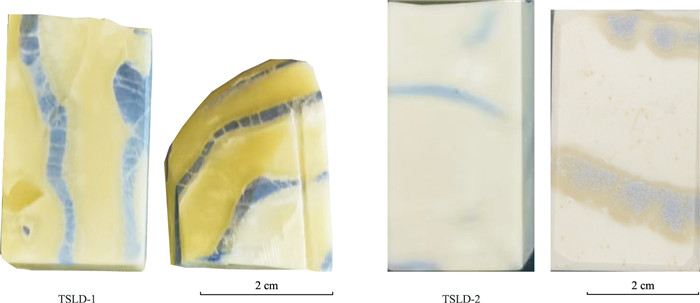
 下载:
下载:
